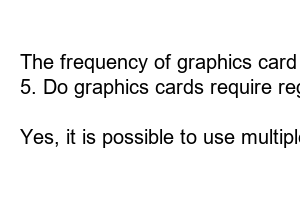그래픽카드 비교
Title: Graphics Card Comparison: Unlocking the Power of Visual Performance
Introduction:
Graphics cards are the beating hearts of modern computing, responsible for delivering stunning visuals and immersive gaming experiences. As the demand for high-quality graphics increases, choosing the right graphics card becomes crucial. In this blog post, we will compare and contrast some of the top graphics cards available in the market, helping you make an informed decision when it comes to upgrading or building your dream system.
1. The Importance of Graphics Cards in Visual Performance:
Graphics cards play a pivotal role in rendering images, videos, and games on your computer screen. By offloading graphics processing from the CPU to a dedicated GPU, they enable seamless and high-speed graphical computations, resulting in a visually appealing and lag-free experience.
2. Graphics Card Comparison – Performance vs Price:
While there is a wide range of graphics cards available, the main differentiating factor is performance versus price. Understanding the balance between these two aspects is crucial in choosing the graphics card that best suits your needs.
3. NVIDIA GeForce RTX Series: Cutting-Edge Visuals Acknowledged:
Boasting top-of-the-line features such as ray tracing and artificial intelligence capabilities, the NVIDIA GeForce RTX series sets the benchmark for graphics cards. With exceptional performance and stunning visual fidelity, these cards deliver an unparalleled gaming and content creation experience.
4. AMD Radeon RX Series: Powerhouse Graphics for Enthusiasts:
The AMD Radeon RX series has captured the attention of gamers and content creators alike. With their powerful performance and affordability, these graphics cards are ideal for those seeking an outstanding visual experience without compromising their budget.
5. Key Factors Influencing Graphics Card Purchase Decisions:
When making a graphics card purchase, several factors should be considered. These include VRAM capacity, clock speed, thermal design power, number of CUDA cores, and compatibility with your system. Evaluating these aspects will help you determine which card aligns best with your performance requirements.
6. Overclocking: Squeezing Out Extra Power:
For users seeking to maximize their graphics card’s potential, overclocking is an option worth exploring. By increasing the clock speed and core voltage, users can push their graphics card beyond its factory-set limits to unlock additional performance gains. However, caution must be exercised to prevent overheating and potential damage.
Summary:
In this blog post, we explored the importance of graphics cards in delivering impressive visual performance. We compared the NVIDIA GeForce RTX series and the AMD Radeon RX series, highlighting their distinct advantages. Additionally, we discussed key factors to consider when purchasing a graphics card and the potential benefits of overclocking. By understanding these aspects, you can choose a graphics card that meets your specific needs and takes your visual experience to new heights.
FAQs:
1. Can I use a high-performance graphics card for everyday tasks?
Absolutely! While high-performance graphics cards are designed to handle graphics-intensive tasks like gaming and content creation, they also enhance the visual experience for everyday tasks like web browsing, watching movies, and even editing photos.
2. Are all graphics cards compatible with my computer?
No, compatibility is essential when choosing a graphics card. Ensure your computer’s power supply, motherboard, and video slots are compatible with the chosen graphics card. Check the manufacturer’s specifications and seek professional advice when necessary.
3. Can I mix NVIDIA and AMD graphics cards in the same system?
Mixing NVIDIA and AMD graphics cards is possible, but it is generally not recommended due to potential driver conflicts. It is best to stick with one brand for smooth operation and optimal compatibility.
4. How frequently should I upgrade my graphics card?
The frequency of graphics card upgrades depends on personal preferences, budget, and the latest technological advancements. On average, upgrading every 2-3 years ensures you stay up-to-date with the latest performance and visual enhancements.
5. Do graphics cards require regular maintenance?
While graphics cards do not require regular maintenance, it is essential to keep them clean to prevent dust accumulation. Regularly dusting off the fans and heat sinks will help maintain optimal cooling performance and prolong the lifespan of your graphics card.
6. Can I use multiple graphics cards simultaneously?
Yes, it is possible to use multiple graphics cards in a single system through a technology called SLI (Scalable Link Interface) for NVIDIA cards or CrossFire for AMD cards. This enables increased graphics processing power, but it is recommended for advanced users and specific applications.

